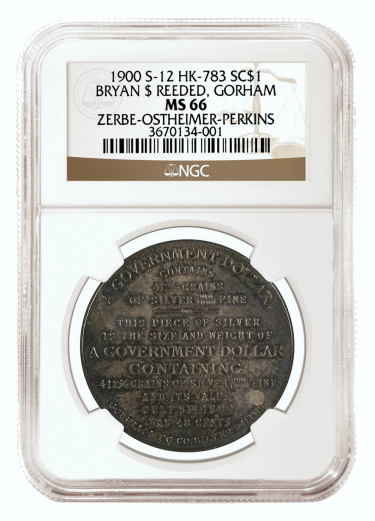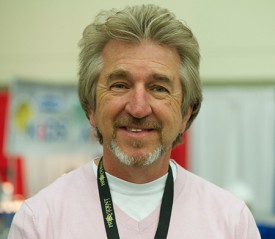
By Jeff Garrett for NGC Market Report ……
Many assume that rare coin dealers have built incredible collections from the coins that they regularly trade. That is not often the case.
Earlier this week, my local coin club met on the second Monday of the month, as usual. This month, a young intern who is working for me gave an interesting talk on the subject of So-Called Dollars. He had learned about this rather obscure subject while helping me organize my personal collection of these interesting items. A few in the audience were surprised that I actually had a collection of So-Called Dollars. Many assume that my personal collection would be much more mainstream in nature. When friends or new acquaintances find out that I am a professional coin dealer, most will at some point ask what I collect. Quite a few imagine that I have assembled a great collection of United States coins. That is very far from the truth, and this is the case for many of my fellow professional coin dealer friends.
 This is an interesting subject, as an insight into the collecting habits of professional coin dealers is probably viewed by some as insider information. What do coin dealers who handle millions of dollars’ worth of rare coins each year collect for themselves? The answer is quite varied with a great deal of diversity. Many rare coin dealers actually limit their collecting habits to fields other than numismatics. Several rare coin dealers have built impressive art collections, and others have concentrated on rare documents, early Americana, and antiques. Some feel that collecting rare coins and shopping for clients at the same time would be a conflict of interest. This is a valid concern and is an issue that seems to seldom surface in the rare coin business.
This is an interesting subject, as an insight into the collecting habits of professional coin dealers is probably viewed by some as insider information. What do coin dealers who handle millions of dollars’ worth of rare coins each year collect for themselves? The answer is quite varied with a great deal of diversity. Many rare coin dealers actually limit their collecting habits to fields other than numismatics. Several rare coin dealers have built impressive art collections, and others have concentrated on rare documents, early Americana, and antiques. Some feel that collecting rare coins and shopping for clients at the same time would be a conflict of interest. This is a valid concern and is an issue that seems to seldom surface in the rare coin business.
As mentioned earlier, my personal collection of rare coins actually includes a very limited number of rare United States coins. My personal reasons for this are mostly cost. Coins that would excite me after 40 years of numismatic trading are way beyond my “put away” budget. This is actually an interesting rare coin dealer term. When a rare coin dealer runs across something they like, they will often “put away” the coin. This is much different than assembling a collection. It is simply finding something that peaks your interest that you deem worthy of saving. I have boxes and boxes of coins that fit this category. Most are world coins that seemed like a great value when purchased. My random boxes of “put away” coins also includes ancient coins that appealed to me for one reason or another.
Another way that coin dealers form collections can be illustrated by the aforementioned collection of So-Called Dollars. Years ago, a friend sold me a partial collection of these interesting medals. This peaked my interest and I began to look for coins that the collection was missing. The coins are beautiful, rare, and are a great value compared to what similar rarity United States coins would cost. I enjoy running across new examples and also learning about the series. My collection also includes a set of small size Kentucky Nationals that was started in the same manner. The purchase of a modest collection led to an obsession to find an example from every bank that issued these. If anyone can help me find one from Horse Cave, Kentucky, dinner is on me!
There have been some great collections of United States coins assembled by professional rare coin dealers. Norman Stack of Stack’s Rare Coins in New York built one of the best type sets of United States coins ever assembled. Ed Milas collected No Motto Half Eagles. A few years ago, Heritage sold the “put away” coins that David Akers collected for decades. His great eye and the amazing low prices of coins in the 1960s and 1970s proved a lucrative combination. Quite a few other coin dealer friends still have incredible collections of great United States coins. Most were started years ago, as the task of finding and saving great United States coins is much more difficult given the prices in recent years.
 One of the best coin dealer collections of all time was the silver dollar set assembled by the late Jack Lee. He loved silver dollars so much that he built and sold his collection several times. Although Jack was a much beloved figure on the rare coin circuit, his wealth was mainly acquired outside of numismatics. Most rare coin dealers look for value when assembling a collection or “putting away” coins. This is probably the biggest lesson to be learned from the collecting habits of professional coin dealers. The next time you talk rare coins with your primary source of numismatics items, find out what they collect. The knowledge could be valuable and you might start your own “put away” box!
One of the best coin dealer collections of all time was the silver dollar set assembled by the late Jack Lee. He loved silver dollars so much that he built and sold his collection several times. Although Jack was a much beloved figure on the rare coin circuit, his wealth was mainly acquired outside of numismatics. Most rare coin dealers look for value when assembling a collection or “putting away” coins. This is probably the biggest lesson to be learned from the collecting habits of professional coin dealers. The next time you talk rare coins with your primary source of numismatics items, find out what they collect. The knowledge could be valuable and you might start your own “put away” box!
Questions about the rare coin market? Send them to [email protected].





Great article. I collect Fugio coppers by variety, large cents by color, some Confederate, southern state and obsolete paper money, and Civil War US large type paper money.
Quite a number of prominent numismatists in history are or have collected early political campaign tokens, medals, ferrotypes, ribbons, ballots, banners, etc. going back to Geo Washington and ranging through Andrew Jackson, Abraham Lincoln on up to Theodore and Franklin Roosevelt. Such luminaries as Wayte Raymond, Fred C.C. Boyd, John J. Ford, Jr, Philip Straus, this writer, Jim Halperin and even the author Jeff Garrett (interest in Henry Clay).
Going back to the 1860’s auction catalogues, offerings include early political tokens and medals and ribbons.
You can get so much more for your dollar in rarity, historical significance and aesthetics with early pre-1970 politicals (certain rare JFK 1960 campaign buttons have exceeded $10K) than with coins. The coin hobby has priced itself to the point where few can afford anything anymore except “moderns”. Not so with politicals which I like to equate to the coin hobby in the 1950’s in terms of price and collectors. A really rare early political that say is worth $5K would equate today to a $250K coin and be alot rarer.
I own a Civil War coin similar to Alan Weinberg’s engraved 1859 Seated Dollar and would like some idea of it’s value. If anyone is interested, I would be glad to send pictures and proof of authenticity. Also, can anyone provide me with Weinberg’s email address?